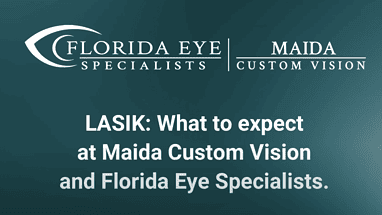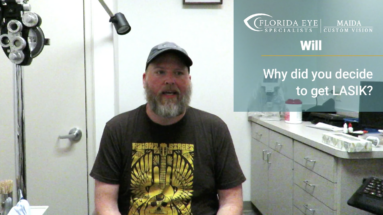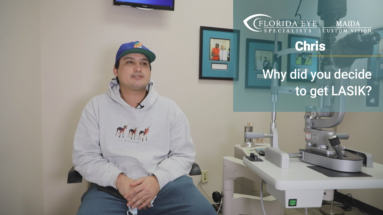Hear from our Clinical Director and Laser Suite Supervisor, D.D. Jewell, about what you can expect during your complimentary LASIK…
Adjusting to Your Intraocular Lenses after Cataract Surgery

If you have cataracts, you should understand that it may take some time to adjust to your intraocular lenses after cataract surgery. At Maida Custom Vision in Jacksonville, FL, our team of doctors will help you select the intraocular lens (IOL) that is right for you. This will make your improve your recovery and help you adjust to your new lenses. With our comprehensive eye care services and compassionate team, you can feel confident about undergoing cataract surgery at our office.
Types of Intraocular Lenses
Intraocular lenses are artificial lenses implanted into the eye after the eye’s natural lens has been removed during cataract surgery. When cataracts develop, the natural lens becomes clouded, hindering your vision. To eliminate cataracts, we must remove the natural lens. To restore your vision after removing the lens, we will insert an IOL in its place. The IOL we place will depend in part on your vision prior to cataracts, your budget, as well as your individual goals.
Multifocal/Accommodative IOLs
Posterior chamber intraocular lenses (PCIOLs), or multifocal IOLs, are an advanced IOL option. They have grown in popularity, primarily because they allow clearer vision at multiple distances rather than just a single distance. This means you can see both near and far without the need for contacts or glasses.
Monofocal IOLs
With a monofocal IOL, we can correct nearsightedness or farsightedness, but not both. Most patients typically choose to correct their distance vision and then rely on reading glasses for up-close work.
Toric IOLs
These IOLs are specifically designed for patients with astigmatism, or nearsightedness or farsightedness. Toric IOLs work similarly to toric contact lenses. They require precision placement, however, in order to properly correct astigmatism.
Monovision
This option uses an IOL in one eye to correct distance vision, and another IOL in the second eye to correct near vision. The combination of the two allows you to see objects both up close and at a distance, typically without the need for reading glasses or other corrective lenses.
How Your IOL Choice Could Affect Your Recovery and Vision
Depending on the IOL you choose for your cataract surgery, it may take three to six weeks before your vision fully stabilizes. You may find it especially difficult to adjust to monovision. Typically, cataract surgery is performed separately on each eye, about a week apart. During the first few days, you will likely experience blurred vision and some discomfort.
You may need to wear an eye patch or other protective bandage for a few days after surgery. We will prescribe eye drops to reduce inflammation and prevent infection. Typically, within eight weeks, both eyes should have fully healed and your vision should be stable. While cataract surgery and the use of IOLs can reduce your dependence on glasses or contacts, most patients still need reading glasses, or a lighter general prescription.
Learn More about Cataract Surgery and IOLs
If you have cataracts, our expert doctors can remove the cataracts and improve your vision with an IOL. To learn more about he procedure and find out which type of IOL is right for you, contact our ophthalmological office today.



